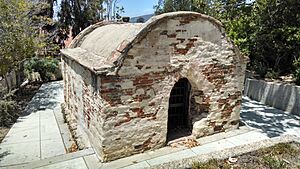City of Ventura Historic Landmarks and Districts facts for kids
The City of Ventura Historic Landmarks and Districts are special places in Ventura, California that have been chosen for their important history. These include old buildings, interesting sites, and even whole neighborhoods. They help us remember the past and understand how Ventura grew over time.
The first six places were named Ventura Historic Landmarks (VHL) in February 1974. These included the Olivas Adobe, a very old house, and the Ventura City Hall. Other early landmarks were the Mission San Buenaventura and its tall Norfolk pine trees. By April 2018, Ventura had named 111 historic landmarks and five special historic districts. These districts are areas with many historic buildings close together.
You can see where these landmarks and districts are on a map! Just click "OpenStreetMap" or "Google Maps" in the box you see on the right side of this page.
Contents
Ventura's Historic Landmarks
Ventura has many cool historic spots. Here are some of the most interesting ones:
| VHL No. | Name | Image | What it is | When it became historic | Cool Facts |
| 1 | Olivas Adobe |  |
4200 Olivas Park Drive | February 11, 1974 | This old adobe house was built in 1837. It's now a museum where you can learn about life long ago. |
| 2 | Ortega Adobe |  |
215 W. Main St. | February 11, 1974 | Built in 1857, this adobe used roof tiles from the Mission after an earthquake. It was the first home of the Ortega chili company! |
| 3 | Father Serra statue |  |
501 Poli St. | February 11, 1974 | A statue of Junípero Serra stands in front of City Hall. The first one was made of concrete, but a bronze one replaced it in 1989. |
| 4 | Ventura City Hall |  |
501 Poli St. | February 11, 1974 | This beautiful building was a courthouse built in 1912. It became Ventura's City Hall in 1972. Look for the cool copper dome! |
| 5 | Grant Park cross site |  |
Ferro Drive | February 11, 1974 | A cross has stood here in Grant Park for many years. Some say the first one was put up in 1782. |
| 6 | Mission Plaza archeological site |  |
100 Block E. Main St. | February 11, 1974 | This is an old digging site next to the Mission. The Albinger Museum is also part of this area. |
| 7 | Conklin residence |  |
608 E. Thompson Blvd. | May 6, 1974 | This house was built in 1877 in the Cape Cod style. It's part of another historic area called the Mitchell Block. |
| 8 | Mission Norfolk Pines | 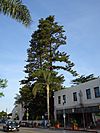 |
211 E. Main St. | July 1, 1974 | These tall Norfolk Island pine trees were planted in the 1880s next to the Mission. They are lit up during Christmas! |
| 10 | Mission San Buenaventura |  |
211 E. Main St. | July 1, 1974 | This was the ninth Spanish mission built in California. Father Junípero Serra started it in 1782. |
| 11 | Plaza Park Moreton Bay Fig Tree |  |
Corner of Chestnut and Santa Clara Streets | July 1, 1974 | This huge Moreton Bay fig tree was planted in 1874. It's 68 feet tall with branches spreading 130 feet wide! |
| 12 | Mission Plaza Moreton Bay Fig Tree |  |
100 block E. Main St. | July 1, 1974 | Another large Moreton Bay fig tree, also planted around 1874. It's part of the historic Mission district. |
| 17 | First Baptist Church of Ventura |  |
101 S. Laurel St. | December 1, 1975 | This church was built in 1931 with a unique Mayan Revival style. It's now the Ventura Center for Spiritual Living. |
| 19 | Elizabeth Bard Memorial Hospital |  |
121 N. Fir St. | March 8, 1976 | Opened as a hospital in 1902, this building has a Mission Revival design. It's now an office building. |
| 20 | Ventura Pier |  |
Harbor Blvd. east of California St. | March 29, 1976 | The first wooden pier here was built in 1872. It was once the longest wooden pier in California! |
| 21 | Emmanuel Franz House |  |
31 N. Oak St. | March 29, 1976 | This house was built in 1879 in the Italianate style. |
| 24 | Ventura Theatre |  |
26 S. Chestnut St. | October 4, 1976 | This movie theater was built in 1928. Now, it's a popular place for live music concerts. |
| 29 | Post Office murals |  |
675 E. Santa Clara St. | October 24, 1977 | These murals were painted in 1936-1937 as part of a government art project. |
| 32 | Peirano Store |  |
204 E. Main St. | January 16, 1978 | This red brick building from 1877 is Ventura's oldest surviving brick structure. The Peirano family ran a grocery store here for over 100 years. |
| 35 | Feraud General Merchandise Store |  |
2 W. Main St. | July 17, 1978 | This building started as a bakery and grocery store in 1903. It's now a bar and lounge. |
| 44 | Dudley House |  |
197 N. Ashwood Ave. | January 21, 1980 | This Victorian farmhouse was built in 1892. It's now used for events. |
| 58 | San Buenaventura Mission Aqueduct |  |
East end of Vince and Lewis Streets | August 2, 1982 | This seven-mile long aqueduct was built starting in 1792. It brought water to the Mission and local farms. |
| 80 | Pierpont Inn |  |
550 Sanjon Rd. | February 1, 1993 | This inn was built in 1910 in the American Craftsman style. It was made for people traveling by car. |
| 85 | San Buenaventura Mission Lavanderia | 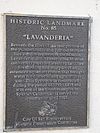 |
204-208 E. Main St. (underneath) | November 14, 1994 | These are the old remains of the Mission's laundry area. They were found in 1991 under other buildings! |
| 86 | Erle Stanley Gardner Office | 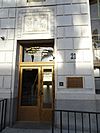 |
21 S. California St. | February 6, 1995 | This was the law office of Erle Stanley Gardner. He was the famous author who wrote the "Perry Mason" books! |
| 88 | WWII artillery emplacements |  |
Near Ventura River Mouth | September 1998 | These old artillery sites were built in 1942. They were made to protect the coast after a Japanese submarine attacked nearby. |
| 91 | China Alley Historic Area | 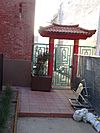 |
200 Block E. Main Street | Perpendicular to Figueroa Street between Main and Santa Clara Streets | This area was the center of Chinese community and businesses starting in the 1880s. |
| 99 | Elks Ventura Lodge No. 1430 |  |
11 S. Ash St. | May 5, 2008 | This building was built in 1928 in the Spanish Colonial Revival style. It was home to the Elks club for many years and is now Hotel San Buena. |
Ventura's Historic Districts
Historic districts are special areas that have many historic buildings. They help protect the unique look and feel of a neighborhood.
| Name | Image | What it is | Cool Facts |
| Mission Historic District |  |
Santa Clara St. (south), Ventura Ave. (west), Poli St. (north), Palm Street (east) | This is the oldest part of downtown Ventura, right around the Mission San Buenaventura. It has more than ten historic landmarks! |
| Mitchell Block Historic District |  |
Plaza Park/Houses at 608, 620, 632, 644, 658, 670, 682 and 692 Thompson Boulevard | This district includes Plaza Park and old homes across from it. It's known as the only block of old houses downtown that hasn't changed much. |
| Selwyn Shaw Historic District | 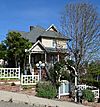 |
Buena Vista St. (north), Ann St. (west), Hemlock St. (east), Poli St. (south) | This city block has three historic landmarks, including the Selwyn Shaw House. |
| Simpson Tract Historic District | Upload image | Sheridan Way (west), Ventura Avenue (east), W. Prospect St. (south), W. Simpson St. (north) | This district has 182 homes built from 1925 to 1930. They provided homes for workers during Ventura's oil boom. |
| Ivy Lawn Cemetery Historic District | 5400 Valentine Rd. | This cemetery became a historic district in 2013. It's important for its architecture and because many important people are buried there. |
Other Important Historic Places
Ventura has other historic spots that have received special recognition:
- Old Mission Reservoir: This was part of the water system for Mission San Buenaventura. It was a settling tank for water and can be found in Eastwood Park.
- Santa Gertrudis Asistencia (Chapel) Monument: This monument marks the spot of a chapel built in 1809. The original remains were moved in 1968 to build a freeway.
- Five Trees: These are five blue gum eucalyptus trees on a hilltop overlooking Ventura. They were planted in 1898. Though many have been cut down or replaced over the years, they remain a local landmark.
See also



